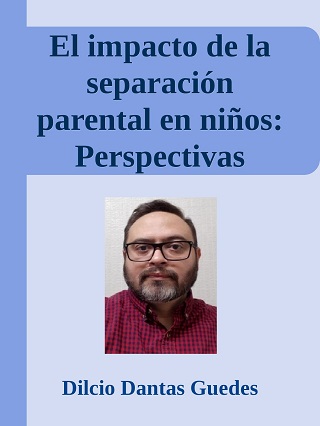Adámy, L., Soltész, K., Szládovics, L., Takács, S., Törő, K.T. (2018). The effects of contested divorce on children’s emotional state based on their family drawings and life quality. Integrative Neuroscience Research, 2(1), 1-7.
Attili, G., Toni, A., Di Gianfelice, S., y Roazzi, A. (2011). Children’s Family Drawings and Attachment: A Multidimensional Scaling Approach to study Internal Working Models. In: Yael Fisher, y Isaac A. Friedman (Eds.), New Horizons for Facet Theory: Searching for Structure in Content, Spaces and Measurement (pp. 111-122). FTA.
Bambico, F.R., Lacoste, B., Hattan. P.R., y Gobbi, G. (2013) Father absence in the monogamous California mouse impairs social behavior and modifies dopamine and glutamate synapses in the medial prefrontal cortex. Cerebral Cortex, 25 (5), 1163-1175 DOI: 10.1093/cercor/bht310.
Berg, B., y Kelly, R. (1979) The Measured Self-Esteem of Children from Broken, Rejected, and Accepted Families. Journal of Divorce, 2(4), 363-369, DOI: 10.1300/J279v02n04_03
Boccia, M. L., Cook, C., Marson, L., y Pedersen, C. (2021). Parental divorce in childhood is related to lower urinary oxytocin concentrations in adulthood. Journal of Comparative Psychology, 135(1), 74–81. https://doi.org/10.1037/com0000248
Burgner, M., y Gavshon, A. (1981). Study Group on One-Parent Families. Bul. Anna Freud Centre, 4(4), 292-294
Camara, K. y Resnick, G. (1988). lnterparental Conflict and Cooperation: Factors Moderating Children's Post-Divorce Adjustment. ln E. Hetherington y J. Arasteh (Eds.), Impact of divorce, single parenting, and stepparenting on children. (pp.169-195). Lawrence Erlbaum.
Camara, K., y Resnick, G. (1989). Styles of Conflict Resolution and Cooperation between Divorced Parents: Effects on Child Behavior and Adjustment, American Journal of Orthopsychiatry, 59(4), 556-575.
Caron, C. (2004). Séparation et divorce fortement conflictuels et syndrome d'aliénation parentale : lecture théorique et intervention. Mémoire de Maitrise en Service Social. Université de Montréal.
Cohen, A.J., Adler, N., Kaplan, S.J., Pelcovitz, D., y Mandel, F.S. (2002) Interactional effects of marital status and physical abuse on adolescent psychopathology. Child Abuse y Neglect, 26(3), 277–288. DOI: 10.1016/s0145-2134(01)00325-8
Ebling, R., Pruett, K.D., y Pruett, M.K. (2009). “Get over it”: perspectives on divorce from young children. Family Court Review, 47(4), 665–681.
Emery, R. (1982). Interparental Conflict and the Children of Discord and Divorce, Psychological Bulletin, 92(2), 310-330.
Fan, R. J. (2012). A study on the kinetic family drawings by children with different family structures. The International Journal of Arts Education, 173-204.
Giotsa, A. y Mitrogiorgou, E. (2016). Representations of Families through the Children’s Drawings in Parental Divorce Incidents in Greece. Journal of Child Development Disorder, 2(4). DOI: 10.4172/2472-1786.100037
González, Y. E. C. (2016). Estrategias que minimicen el impacto psicosocial en los niños de madres solteras de 6 a 12 años, del centro de alcance por mi barrio, de Santa Catarina Pínula. Informe de Investigación. Universidad de San Carlos de Guatemala.
Grych, J. y Fincham, F. (1990). Marital conflict and children's adjustment: A cognitive contextual framework. Psychological Bulletin, 108, 267 -290.
Helmreich, D.L., Parfitt, D.B., Lu, X-Y, Akil, H., y Watson, S.J. (2005) Relation between the hypothalamic-pituitary-thyroid (HPT) axis and the hypothalamic-pituitary-adrenal (HPA) axis during repeated stress. Neuroendocrinology, 81(3), 183–192. DOI: 10.1159/000087001
Hetherington, M.E., Cox, M., y Cox, R. (1979). Play and social interaction in children following divorce. Journal of Social Issues, 35, 79-96.
Hoffman, K.A., Mendoza, S.P., Hennessy, M.B., y Manson, W.A. (1995) Responses of infant Titi monkeys, Callicebus Moloch, to removal of one or both parents: Evidence for paternal attachment. Developmental Psychobiology, 28(7), 399–407. DOI: 10.1002/dev.420280705
Ivanoff, E. (1909) Expériences sur le dessin des écoliers suisses : la corrélation entre l'aptitude au dessin et d'autres capacités. Archives de Psychologie, 8, 97-156.
Jekielek, S. M. (1998). Parental Conflict, Marital Disruption and Children’s Emotional Well-Being. Social Forces, 76(3),905-935.
Johnson, J.G., Cohen, P., Kasen, S, y Brook, J.S. (2002) Childhood adversities associated with risk for eating disorders or weight problems during adolescence or early adulthood. The American Journal of Psychiatry, 159(3), 394–400. DOI: 10.1176/appi.ajp.159.3.394
Johnston, J., Kline, M., y Tschann, J. (1989). Ongoing Post-Divorce Conflict: Effects on Children of Joint Custody and Frequent Access. American Journal of Orthopsychiatry, 59(4), 576-592.
Kacenelenbogen, N., Dramaix-Wilmet, M., Schetgen, M., Roland, M., y Godin, I. (2016). Parental separation: a risk for the psychomotor development of children aged 28 to 32 months? A cross-sectional study. BMC pediatrics, 16, 89. DOI: 10.1186/s12887-016-0621-y
Kelly, J. B., y Wallerstein, J. S. (1976). The effects of parental divorce: Experiences of the child in early latency. American Journal of Orthopsychiatry, 46(1), 20–32. https://doi.org/10.1111/j.1939-0025.1976.tb01224.x
Kelly, R., y Berg, B. (1978). Measuring children's reactions to divorce. Journal of Clinical Psychology, 34(1), 215–221.
Kline, M., y Johnston, J.R. (1991). The long shadow of marital conflict: A model of children's postdivorce adjustment. Journal of Marriage and the Family, 53,297-309
Lamela, D.; Figueiredo, D.; y Bastos, A. (2010). Adaptação ao divórcio e relações coparentais: contributos da teoria da vinculação. Psicologia Reflexão e Critica, 23(3), 562-574.
Lampel, A. (1996). Children's alignment with parents in highly conflicted custody cases. Family and Conciliation Courts Review, 34(2),229-239.
Lassonde-Fontaine, L. (1973). Les effets de l'absence du père chez le garçon au cours de sa période œdipienne (étude exploratoire). Mémoire de Maîtrise non publié, Université de Montréal.
Leite-Anderson, D.A. (1992). Effects of divorce on children's family drawings by children in two age groups. Masters of Sciences Dissertation. Emporia State University.
Lima, B.E.M. (2014). A Dupla Lua: indicadores de validação junto de filhos de famílias divorciadas. Dissertação de Mestrado Psicologia. Universidade Católica Portuguesa.
Madden-Derdich, D.A., Leonard, S.A., y Christopher, F.S. (1999). Boundary Ambiguity and Coparental Conflict After Divorce: An Empirical Test of the Family Systems Model of the Divorce Process. Journal of Marriage and the Family, 61, 588–98.
Mahler, M. S., y Rabinovitch, R. (1956). The effects of marital conflict on child development. En Eisenstein, V. W. (eds.), Neurotic Interaction in Marriage (pp. 44-56). Basic Books.
Maier E. H., y Lachman, M.E. (2000) Consequences of early parental loss and separation for health and well-being in midlife. International Journal of Behavioral Development 24(2), 183–189. DOI: 10.1080/016502500383304
Martinón, J.M., Fariña, F., Corras, T., Seijo, D., Souto, A., y Novo, M. (2017). Impacto de la ruptura de los progenitores en el estado de salud física de los hijos. European Journal of Education and Psychology, 10 (1), 9-14. DOI: 10.1016/j.ejeps.2016.10.002
Mathis, R. (1998). Couples from Hell: Undifferentiated Spouses in Divorce Mediation. Mediation Quarterly, 16, 37-49.
Melanson, D. (1973). Etude du dessin de famille chez des enfants de parents séparés, privés de leur père. Mémoire de Maîtrise non publié, Université de Montréal.
Mento, C., Modicamore, D., La Torre, D., Sivestri, M. C., y Rizzo, A. (2019). Family drawing and psychological vulnerability in children’s representations of parental divorce. Cogent Psychology, 6. DOI: 10.1080/23311908.2019.1654723
Mirivahid, S.M., Abbassi, H., y Heydarnia, A. A. (2016). Comparison of kinetic family drawing indicators in intact and divorced children. Journal of Fundamentals of Mental Health, 18(6), 329-37.
Mueller, I., y Tronick, E. (2019). Early Life Exposure to Violence: Developmental Consequences on Brain and Behavior. Frontiers in Behavioral Neuroscience, 13, 156. https://doi.org/10.3389/fnbeh.2019.00156
Nelson, R. (1989). Parental Hostility, Conflict and Communication in Joint and Sole Custody Families. Journal of Divorce, 13(2), 145-157.
Nye, I. F. (1957). Child adjustment in broken and in unhappy unbroken homes. Marriage and Family Living, 19,356-361.
Olofsson, E. (2019). Children of Divorce: Long-Term Psychological Effects and Neurological Consequences. Bachelor Degree Project in Cognitive Neuroscience, University of Skövde.
Orgilés, M. y Piñero, J. (2007). ¿Cómo perciben los niños la ruptura familiar? Aplicación del test del Dibujo de la Familia en una muestra de hijos de padres separados. Psicopatología y Salud Mental, 9, 49-55.
Ovtscharoff, W., Helmeke, C., y Braun, K. (2006) Lack of paternal care affects synaptic development in the anterior cingulate cortex. Brain Research, 1116(1), 58–63. DOI: 10.1016/j.brainres.2006.07.106
Parish, T., y Dostal, J.W. (1980). Evaluations of self and parent figures by children from intact, divorced, and reconstituted families. Journal of Youth and Adolescence, 9, 347-351.
Parish, T.H., y Taylor, J.C. (1979). The impact of divorce and subsequent father absence on children’s and adolescent’s self-concept. Journal of Youth and Adolescence, 8, 427-432.
Procaccia, R., Miragoli, S., Camisasca, E.y Di Blasio, P. (2020) Children in Conflictual Separations: Representations of Self and Family through the Blacky Pictures’ Test. Journal of Forensic Psychology Research and Practice, 20(2), 185-204, DOI: 10.1080/24732850.2020.1714404
Raschke, H., y Raschke, V. (1979). Family Conflict and Children’s Self-Concepts: A Comparison of Intact and Single-Parent Families. Journal of Marriage and the Family, 41, 367-374.
Roustit, C., Campoy, E., Renahy, E., et al. (2011) Family social environment in childhood and self-rated health in young adulthood. BMC Public Health, 11(949). DOI: 10.1186/1471-2458-11-949
Şeno, T. (2014). Research about Family Perceptions via Pictures of Children from Problematic Families or Having Divorced Parents. Procedia. Social and Behavioral Sciences, 116, 2895 – 2902.
Simons, R., Lin, K, Gordon, L. Conger, R. y Lorenz, F. (1999). Explaining the higher incidence of adjustment problems among children of divorce compared with those in two-parent families. Journal of Marriage y the Family, 61(4), 1020-1034
Spigelman, G., Spigelman, A., y Englesson, L. (1992). Analysis of family drawings: A comparison between children from divorce and non-divorce families. Journal of Divorce and Remarriage, 18, 31-54.
Tschann, J. M., Johnston, J. R., Kline, M., y Wallerstein (1989). Family process and children's functioning after divorce. Journal of Marriage and the Family, 51, 431-444.
Wallerstein, J., y Kelly, J. (1975). The effects of parental divorce: experiences of the preschool child. Journal of the American Academy of Children Psychiatric, 14(4), 600-616.
Wallerstein, J., y Kelly, J. (1976). The effects of parental divorce: Experiences of the child in later latency. American Journal of Orthopsychiatry, 46(1), 20-32
Yannakoulia, M., Papanikolaou, K., Hatzopoulou, I., Efstathiou, E., Papoutsakis, C., y Dedoussis, G.V. (2008) Association between family divorce and children’s BMI and meal patterns: The GENDAI study. Obesity, 16(6), 1382–1387.




























